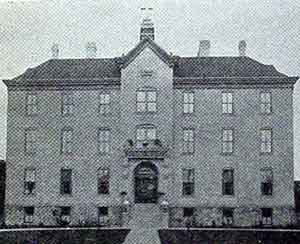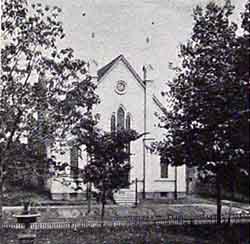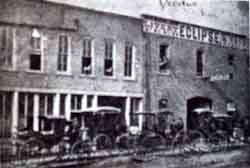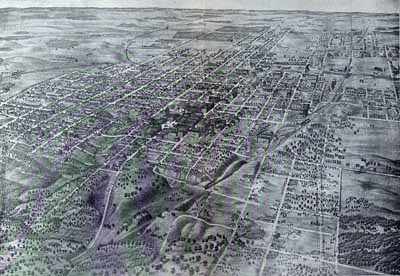|
DECATUR
saw the beginning of its public improvement era
in the '70s. There was not as much
increase in population as might have been
expected although the city had a steady growth,
yet this decade saw the addition of many
business enterprises, as well as the
improvements of a public nature.
Waterworks and fire
department, street car service, new railroads,
public library, hospital, coal mining, and
telephone service were among the necessities and
conveniences which had there start.
The first train to cross the
Wabash bridge over the Sangamon south of town
was a work train which made the crossing on Jan.
13, 1870. The first passenger service on
the Decatur-East St. Louis railroad (now the St.
Louis branch of the Wabash) was given June 7,
1870. The train left at 7:25 a.m. with
sixteen people aboard. Most of them made
the trip merely for the ride. It was
announced that passenger service would be given
on alternate days, the train leaving at 7:25
a.m.
The last rail on the Pekin,
Lincoln & Decatur road was laid Oct. 10, 1871,
but it caused no comment. There was too
much excitement just then over the big fire in
Chicago. Mrs. O'Leary's cow had
started something, and the Chicago catastrophe
was more interesting then new railroads.
The president and directors of the T. W. & W.
road, which had leased the new P. L. & D.
railroad, made the trip over the line from Pekin
to Decatur. They found it rough in spots
but promised good service in a few weeks.
Decatur did its part, by the
way, in aiding the sufferers from the great
disaster in Chicago. Our citizens
contributed 1,436 loaves of bread and $185.50
worth of bacon.
The Illinois Midland, the
railroad from Peoria to Terre Haute, was another
road completed in the '70s. Also the
Indianapolis, Decatur & Springfield line was
completed as far as
Montezuma, Ind., and the Decatur,
Monticello & Champaign line was constructed.
The summer of 1871 will be
remembered by older residents of the city as the
summer of the great drouth.1
Temperature, during the month of August
especially, rarely fell below 90 and much of the
time was around 100. Springs and wells
failed. The Sangamon became a series of
water holes. Many cattle died. It
was necessary to drive cattle long distances to
find water. Pastures dried up. Great
losses were suffered by the farmers.
The drouth was felt all over
the state.
That was the year of the
Revere hotel fire, which had such an effect on
the business section of Decatur.
The Daily Republican, a
leading newspaper in Decatur for years, was
started April 1, 1872, with B. K. Hamsher
and J. R. Mosser as publishers.2
The Decatur Local Review, a new weekly paper
published by A. Wuench, made its first
appearance March 4, 1873. It was the
beginning of the present day Review.
In November, 1870, Macon
county's new court room in the Powers building
was formally opened. The old brick court
house was sold to Martin Forstmeyer for
$385. It was torn down during the winter
of 1870.
In 1870 came the Rolling
mill. In that year the waterworks plant
was built. The fire department was
organized in 1872. The county farm was
established and the main building erected in
1873. This building burned in 1882,
several inmates losing their lives.
In 1876 the first street car
service was started.
Smith's Opera house was
formally opened to the public in September,
1870. People were delighted with it.
The motto of the stage was, "Dedicated to Free
Speech". Katie Putnam was the leading lady
in the play, "Frou Frou", which was the
attraction on the opening night.
The Decatur public library
was organized in 1875. St. Mary's hospital
was started in 1878 in a frame house, and the
next year a brick building was erected. In
1877 the Y. M. C. A. was organized.

ST. MARY'S HOSPITAL - FIRST
BUILDING
This was the period when
Haworth check rower factory was building up
fortunes for its owners. The check rower
was the invention of George D. Haworth in
1869, and that fall he formed a partnership with
his father, Mahlon, and brothers, L. L.
and J. W. Hawworth for its manufacture.
Mr. Haworth had
previously invented corn planters and had
manufactured them in Mechanicsburg. He
moved his business to Decatur in 1861.
Demand for the check rower
increased every year until it became so great it
was impossible to keep the orders filled.
When the business was at its height more than
16,000 were made in a year.
For a number of years the
Haworth factory was the leading manufacturing
business of Decatur and the Haworth homes were
the centers for social and literary groups.
G. D. Haworth lived on East Eldorado
street, the house now St. Patrick's rectory.
J. W. Haworth's home was on North Jackson at
Eldorado and L. L. Haworth's home was at
Edward and Williams streets.
The factory continued making
money until the patents expired and corn planter
manufacturers began making their own check
rowers.
Several churches were erected
in the '70s. The United Brethren church
built a house of worship at the corner of
Broadway and Eldorado.
The Christian church tore
down its building at Main and North streets and
erected a new one on the site under the
leadership of Rev. N. S. Haynes.
This building was moved in 1893 to Edward and
William streets. The accompanying picture
was taken after it was removed to the new site.
The Baptist church bought the
lot at the southeast corner of Water and North
streets and put up a building costing about
$12,000. It was dedicated April 23, 1876.
German Catholics in 1877
organized a church, which was named St. James
church. Later a house of worship and
school were erected on East Clay street.
Ursuline Sisters came from
Alton and in 1873 opened St. Teresa's academy.

EDWARD ST. CHRISTIAN CHURCH
- Photo by J. E. Bering.
Boring for coal started in
1874 by the Western Coal company on a plot of
ground north of the Wabash round house.3
The effort was abandoned when a depth of 50 feet
had been reached without results. Decatur
citizens however, believed there was coal here,
and they subscribed $5,000 for the purpose of
making a thorough test. J. E. Bering
bored the second hole, but it had to be
abandoned on account of quicksand. Another
attempt was made by Mr. Bering and at a depth of
290 feet a stratum of the black diamonds was
discovered. Specimens was placed on
exhibit at the Peddecord and Burrows
bank on Jan. 14, 1876. Two or three years
afterwards a coal shaft was sunk, and later two
other shafts were sunk in Decatur.
In 1879 the waterworks dam
was completed. That same year Decatur had
its first telephone service.
In 1878 the Decatur Tank Line
company was organized, and it served a large
territory. It was a branch of the Standard
Oil company of Cleveland.
In 1871 Adam Blenz and
G. J. Danzeizen started a meat market.
It led to the establishment later of the
Danzeizen Packing house.
S. M. Irwin came to
Decatur in January, 1877, and purchased a stock
of drugs that occupied the building at 100 East
Prairie. His drug store is across the
street now.
Among the industries
established in the '70s was the plant of
Lyon, Gipson & Co., which is still in
business today as the Lyon Lumber company.
The Chambers, Bering and
Quinlan company was formed in 1875 by W. B.
Chambers, W. J. Quinlan and J. E.
Bering, to manufacture the Champion and
Brown hog ringers, Barnes wire check rowers, and
other articles. The company bought the
Decatur Agricultural works plant

CALDWELL'S LIVERY STABLE
Charles M. Caldwell
started a livery business in 1871 which he
continued until 1919. Most of the time it
was located in the 100 block West Main street.
In the halcyon days of the livery business Mr.
Caldwell always kept as many as 50 rigs busy.
Caldwell's barn was known for many miles
around.

Map of Decatur in 1878
Many of the
buildings in the picture were marked in the
original drawing by numbers. Some of them
are not now discernible; others may be seen with
the aid of a magnifying glass.
The numbers showed the following places:
1 - First M. E. church
2 - Stapp's Chapel
3 - St. Patrick's Catholic church
4 - High school
5 - United Brethren church
6 - First Baptist church
7 - Presbyterian church
8 - Janes Chapel
9 - Christian church
10 - German Methodist church
11 - Episcopal church
12 - Rolling Mill Chapel
13 - Bethel church
14 - German Catholic church
15 - African M. E. church
16 - African Baptist church
17 - First Ward school house
18 - Second War school house
19 - Third Ward school house
20 - Fourth ward school house
21 - Lutheran church
22 - Priest house
23 - St. Nicholas hotel
24 - Hose House No. 1
25 - Hose House No. 2
26 - Hose House No. 3
27 - Wayne Bros. Carriage Works
28 - Shellabarger's Mills
29 - Bagging Factory, Conklin Bros.
30 - Coal Oil Works
31 - Haworth & Sons Check Row
32 - Manufactory
33 - Woolen mills
34 - Furniture factory
35 - Union Iron Works
36 - Coffin factory
37 - Elwood Bros. Planing Mill
38 - Decatur Linseed Oil mills
39 - Preist & Co. Illinois Central mills
40 - Midland depot
41 - Union depot
42 - Wabash shops
43 - Decatur Agricultural works
44 - College square
45 - Old Square
46 - City Park
47 - Whitmer's Brick and Tile yard
48 - Harpstrite & Shlaudeman, brewery,
49 - Wabash junction
50 - Fair Grounds
51 - Greenwood cemetery
52 - Slaughter house
53 - Postoffice
54 - Court House block
55 - Hill & Co. Hog Ringing Manufactory
56 - Kramer's Carriage works
57 - St. Claire mills
58 - James A. Millry Illinois Central
paper warehouse.
59 - Fr. Kuny's Steam Bottling works
60 - Gas works
61 - E. B. Pratt's grocery
62 - Globe saloon
63 - Washington Garclen |
64 - Grabs and Gury Concert hall
65 - St. Nick Livery and Bus line
66 - Starr & Sons Harness and Saddle shop
67 - Dennis and Rea, hardware
68 - Challes Bros. Boot and Shoe store
69 - Rufus & Crocker Hardware store
70 - John Thomas Boarding house
71 - Cheap Charley's Clothing house
72 - D. W. Brenneman wholesale liquor
house
73 - J. T. Shea grocer
74 - J. A. Barney Cigar Store
75 - Hubbard & Swerenger Drugs and Books
76 - Jacob Danzeizen Butcher shop
77 - Julius Wickmann Gun shop
78 - John Franks Boot and Shoe shop
79 - J. F. Read's Wagon shop
80 - M. Schneider's Beer hall
81 - N. Weber's Summer garden
82 - Roach and McReynolds dry goods
83 - Charles Grosh Furniture store
84 - Samuel McRoberts grocer
85 - C. W. Aikins wagon shop
86 - W. W. Swerenger drug store
87 - Th. Bauer tailor shop
88 - Theodore Steinen's florist and
gardener
89 - Jacob Kessler's farm
90 - H. B.
Montgomery boot and shoe store
91 - O. E. Curtis jewelry store
92 - W. H. Reeme grocer
93 - Charles Adderley grocer
94 - C. Kepler's cigar store
95 - C. J. Mascott boarding house
95 - H. Mueller & Co. gun shop
96 - Decatur Turn hall
97 - Morning Sun office |
H. Mueller started
business in April, 1874, manufacturing water
main tappers.
Roberts, Lytle
and company in 1873 began the manufacture of
burial caskets, at the corner of Morgan and
North streets. In the firm were T. T.
Roberts, R. P. Lytle and O. Z.
Greene. This was the only casket
manufacturing establishment in this section and
business extended over a number of states.
H. W. Hill and company
(H. W. Hill and C. P. Housum) in
1872 began the manufacture of the hog rings,
ringer and tongs, invented by Mr. Hill.
Business eventually was done from coast to coast
and in Europe. The plant was located at
Main and Church streets.
The Decatur Novelty works,
Farris and Oakes, proprietors, was established
in 1875, was a big industry for a number of
years. It was located on Cerro Gordo, near
Franklin. The firm was composed of Moses
Jerome, A. W. Conklin and D. S.
Shallabarger. At one time it employed
160 men and women.
Herman Post started in the
jewelry business in 1872.
Kaufman and
Bachrach, clothiers, started business about
1877. In 1884 Mr. Bachrach assumed
entire control.
The Decatur Tent and Awning
company began business in 1879.
TEMPERANCE TABERNACLE
Decatur has been the scene of
many temperance movements, the biggest being
during the '70s and '80s, when the entire
country was being swept by the temperance wave.
The Good Templars order, which flourished for
many years, had its start at that time.
The big temperance
tabernacle, which occupied the present site of
the Linn and Scruggs store, was built in 1878
and was ready for the meeting of the National
Christian Temperance Union which was held in
October.4
The dedication of the tabernacle took place Oct.
23, 1878, in connection with that meeting.
Francis Murphy, Colonel H. W. Rowell
and Jake Hoofstitler were among the
speakers.
Franklin Priest was
one of the Decatur men active in the
construction of that building. Among other
things he furnished bricks. The bricks
came from the walls of the old Priest
distillery. It was a a curious coincident
that the material from the old distillery should
go into the walls of the temple of temperance.
Mr. Priest later bought the lot on which
the tabernacle stood.
The tabernacle had a seating
capacity of 3,500 and was the biggest auditorium
Decatur had had up to that time. It was
the scene of all the city's big gatherings for
years. Jake Hoofstitler and other
temperance agitators often spoke there in the
cause of temperance, and temperance plays were
given.
Musical concerts often were
heard in the tabernacle. Once S. M.
Lutz directed a choir of 500 voices in a
concert there. The choir was made up of
voices from Bloomington, Springfield, Pana,
Shelbyville, Paris, Mattoon, Decatur and other
cities. The tabernacle was the scene of
several of the gatherings during the reunion
here of General U. S. Grant's regiment in
October, 1880.
In 1883 T. T. Van Allen
took control of the tabernacle, and made it into
a skating rink. Later it was used as an
armory, for a medicine show, and for business
purposes, the Peter Perl undertaking
establishment and a livery barn being conducted
in it. After the Bachmans bought
the lot the old tabernacle was torn down in
1912, and the present Bachman building on the
site was started.
Professor Charles
Leonard came
to Decatur in 1874 and started a dancing school.
He was assisted by his daughter, Kate (Cassell),
who continued it after his death, teaching the
art altogether for more than fifty years.
On July 4, 1876, Decatur
properly celebrated the nation's centennial.
The illustration, on another page, giving the
program for that day, tells the story.
Decatur's population in 1870
was 7,161. In 1880 the census report
showed 9,547 inhabitants. Though not
making a large gain in numbers, the city had
made progress in other ways and was on a steady
march upward.
-------------------
1.
A Peoria newspaper wag, referring to the drouth
that summer of 1871, wrote as follows:
"The city dads should station the police along
the river, fir if they don't some drunk is going
to wander down there some night and drink up
what is left of the stream."
2.
Joe Cannon was in Decatur in April, 1872,
looking after his prospects as a Republican
candidate for the nomination of congressman.
He got the nomination and won the place.
That was his first term in congress, the
beginning of his long record of service in that
body.
3.
The first boring for coal in Decatur was made in
December, 1869. George W. Darling
made the boring in the Race pasture at the
junction of the T. W. & W. and D. and E. St. L.
The city council appropriated $1,000 to assist
in the work. Many difficulties were met
and finally the work was stopped, and the boring
was transferred to the Johns pasture.
Later Darling left town, and then the excitement
was over. A year previous to this a shaft
had been sunk at Macon, but it was put out of
business by water.
4.
The Decatur W. C. T. U. was started in 1874.
It was first known as the Temperance league.
Mrs. Hiram Buck was the president and
Mrs. H. C.
Johns secretary. Within a few years
the name was changed to Woman's Christian
Temperance Union and the organization affiliated
with the state W. C. T. U. The W. C. T. U.
fountain between the Wabash and Illinois Central
railroad stations, erected in 1906, was donated
by Thomas Davis of Macon.
<PREVIOUS>
<NEXT>
<CLICK HERE TO
RETURN TO TABLE OF CONTENTS>
|